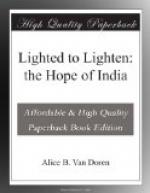[Footnote *: Opposing the study of the Bible in our schools.]
CHAPTER FIVE
SENT FORTH TO HEAL
“THE Long Trail A-Winding.”
Who that has read “Kim” will ever forget Kipling’s picture of the Grand Trunk Road, with its endless panorama of beggars, Brahmans, Lamas, and talkative old women on pilgrimage? Such roads cover India’s plains with a network of interlacing lines, for one of Britain’s achievements on India’s behalf has been her system of metalled roads, defying alike the dust of the dry season and the floods of the monsoon.
One such road I have in mind, a road leading from the old fortress town of Vellore through twenty-three miles of fertile plain, to Gudiyattam, at the foot of the Eastern Ghats. It is just a South Indian “up country” road, skirting miles of irrigated rice fields, gold-green in their beginnings, gold-brown in the days of ripening and reaping. It winds past patches of sugar cane and cocoanut palm; then half arid uplands, where goats and lean cattle search for grass blades that their predecessors have overlooked; then the bizarre shapes of the ghats, wide spaces open to the play of sun and wind and rain, of passing shadow and sunset glory. They are among the breathing spaces of earth, which no man hath tamed or can tame.
An Indian “Flivver.”
An ordinary road it is, and passing over it the ordinary procession—heavy-wheeled carts drawn by humped, white bullocks; crowded jutkas whose tough, little ponies disappear in a rattle of wheels and a cloud of dust; weddings, funerals, and festivals with processions gay or mournful as the case may be. One feature alone distinguishes this road from others of its kind; once a week its dusty length is traversed by a visitant from the West, a “Tin Lizzie,” whose unoccupied spaces are piled high with medicine chests and instrument cases. Once a week the Doctor passes by, and the countryside turns out to meet her.
When the Doctor Passes by.
Where do they come from, the pathetic groups that continually bring the little Ford to a halt? For long stretches the road passes through apparently uninhabited country, yet here they are, the lame, the halt, and the blind, as though an unseen city were pouring out the dregs of its slums. Back a mile from the road, among the tamarind trees, stands one village; at the edge of the rice fields huddles another. The roofs of thatch or earth-brown tiles seem an indistinguishable part of the landscape, but they are there, each with its quota of child-birth pain, its fever-burnings, its germ-borne epidemics where sanitation is unknown, its final pangs of dissolution. But once a week the Doctor passes by.




